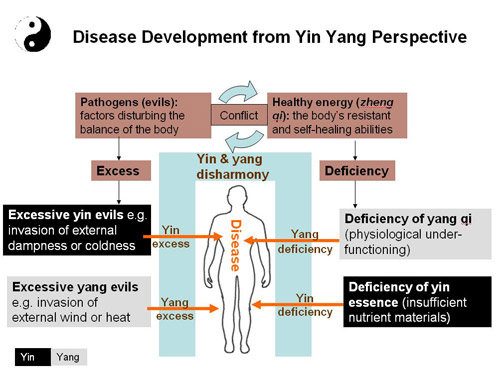Yin Yang Application in Pathological Changes of Chinese Medicine
Traditional Chinese medicine (TCM) believes that health is achieved when the body is in a dynamic balance, meaning that all the body components, including the internal and external body, the upper and lower body, functions and structures, even in between the functional activities or essential substances, are maintain in an integral harmony. Disharmony is the root cause of diseases and physiological disorders. Yin yang theory is used as a way of comparative analysis of body imbalance, and disharmony is referred as the proportions of body's yin and yang are out of their normal limits, becoming unequal and uncoordinated. For example, when one aspect becomes deficient, the other will be in excess, the balance is then disturbed.
From a holistic viewpoint, two aspects must be considered when evaluating disease development: pathogens (TCM term evils) and the body's resistance (TCM term healthy energy). The conflict between the two forces is what allows the disease to either progress or recover to a healthy state. When an individual is strong, and the body functions well and has good immunity, it is easier to recover from a disease.
There are many factors that cause the body to become unbalanced, but they are all related to the conflict between healthy energy and pathogens. Physicians apply the yin yang theory to gain a general picture of disease development and how it runs its course.
The body's resources and abilities to resist can be divided into the material aspect (TCM term yin essence) and the functional aspect (TCM term yang qi). While pathogens include yin and yang evils, for example cold and dampness belong to yin evils; wind, summer heat, and fire belong to yang evils. Yang evils tend to damage yin essence, while yin evils tend to damage yang qi.
Basically, a disease can be interpreted as the result of conflict between the yin and yang forces:

| Problems |
Disharmonies |
Conflict between yin and yang |
Pathological results |
| Abundant yin evils disturb the body |
Yin excess |
The relative proportion of yin is above the normal limit, which overly restricts or even damages yang |
Yin excess leads to coldness: the yin pathogens cause a decline in the body's warming, propelling, excitatory and resistant actions, and so results in cold or weak manifestations such as abdominal pain, diarrhea, sensitive to low temperatures, limb coldness and deep pulse |
| Inadequate of yin essence |
Yin deficiency |
The relative proportion of yin is below the normal limit, which fails to restrict yang. When one recedes, the other predominates, resulting in an apparently excess of yang |
Yin deficiency leads to heat: due to inadequate of nutrient materials, the body is running with proper nourishment or lubrication, and so results in heat manifestations such as hot flashes, night sweats, warm palms and soles, dry mouth, fine and rapid pulse |
| Inadequate of yang qi |
Yang deficiency |
The relative proportion of yang is below the normal limit, which fails to restrict yin. When one recedes, the other predominates, resulting in an apparently excess of yin |
Yang deficiency leads to coldness: deficiency of yang qi means the body is in an overall weakened state, and so results in cold or weak manifestations such as paleness, sensitive to low temperature, cold limbs, fatigue, and sleepiness |
| Abundant yang evils disturb the body |
Yang excess |
The relative proportion of yang is above the normal limit, which overly restricts or even damages yin |
Yang excess leads to heat: the yang evils cause a fierce struggle within the body, and so results in heat and excitatory manifestations such as fever, sweating, red face and rapid pulse |
| Inadequate of both yang qi and yin essence |
Deficiency of yin and yang |
Since yin and yang mutually depend on each other, yin deficiency can eventually cause yang deficiency, while yang deficiency can eventually cause yin deficiency |
Typically seen in chronic health problems, and usually present with depletion of both blood and qi |
|